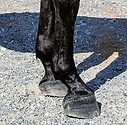Advertise Follow Us
Diseases
How Uneven Feet Affect Locomotion
Understanding the relationship between movement and injury is key
Read More
Lessen Inflammation’s Effect On Joint Health
Farriers’ early recognition can help slow the degeneration of the condition
Read More
Six Reasons for Poor Hoof Quality
Equine vet Scott Morrison examines causes of compromised horn
Read More
Old Horses, New Problems
Aging horses become more susceptible to arthritis, laminitis and other issues that present hoof-care challenges
Read More
The Cost of Treating Laminitis
A veterinarian and three farriers discuss the cost of treatment and how it affects their approach to helping the horse
Read More
Migrating Clients Require Farrier Communication And Collaboration
As seasons change and horses move between locations, farriers in different states must work together to keep horse hooves healthy
Read More













